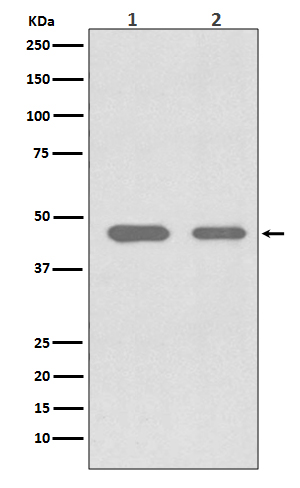
| WB | 1/500-1/1000 | Human,Mouse,Rat |
| IF | 1/20 | Human,Mouse,Rat |
| IHC | 1/50-1/100 | Human,Mouse,Rat |
| ICC | 技术咨询 | Human,Mouse,Rat |
| FCM | 1/50-1/100 | Human,Mouse,Rat |
| Elisa | 咨询技术 | Human,Mouse,Rat |
| Aliases | CDC37; CDC37A; Hsp90 co-chaperone Cdc37; Hsp90 chaperone protein kinase-targeting subunit; p50Cdc37 |
| Entrez GeneID | 11140 |
| WB Predicted band size | Calculated MW: 44 kDa; Observed MW: 50 kDa |
| Host/Isotype | Rabbit IgG |
| Antibody Type | Primary antibody |
| Storage | Store at 4°C short term. Aliquot and store at -20°C long term. Avoid freeze/thaw cycles. |
| Species Reactivity | Human,Mouse,Rat |
| Immunogen | A synthesized peptide derived from human Cdc37 |
| Formulation | Purified antibody in PBS with 0.05% sodium azide. |
+ +
以下是关于CDC37抗体的3篇参考文献,包含文献名称、作者及摘要内容概括:
---
1. **文献名称**:*CDC37 is a molecular chaperone with specific functions in signal transduction*
**作者**:Stepanova L, Leng X, Parker SB, Harper JW
**摘要内容**:该研究揭示了CDC37作为HSP90共伴侣蛋白在激酶稳定中的作用。作者使用特异性CDC37抗体进行免疫共沉淀实验,证实其与多种激酶(如CDK4)的相互作用,并表明CDC37缺失会导致激酶降解,提示其作为癌症治疗靶点的潜力。
---
2. **文献名称**:*Targeting the Hsp90-Cdc37-client protein interaction to disrupt Hsp90 chaperone machinery*
**作者**:Roe SM, Ali MM, Meyer P, Vaughan CK
**摘要内容**:通过结构生物学和生化分析,研究团队利用CDC37抗体阻断HSP90-CDC37复合物的形成,发现小分子抑制剂可破坏该复合物,抑制客户激酶(如BRAF和ERBB2)的活性,为肿瘤治疗提供了新策略。
---
3. **文献名称**:*CDC37 regulates the Glycogen Synthase Kinase 3-mediated phosphorylation of Myc*
**作者**:Miyata Y, Nishida E
**摘要内容**:该研究通过Western blot和免疫荧光技术(使用CDC37抗体),证明CDC37通过调控GSK3β的稳定性影响Myc蛋白的磷酸化,从而影响细胞增殖与肿瘤发生,强调了CDC37在信号通路中的关键作用。
---
以上文献均涉及CDC37抗体的实验应用(如蛋白互作检测、功能机制研究),并关联其在癌症生物学中的重要性。如需更多文献或具体实验细节,可进一步补充关键词检索。
**Background of CDC37 Antibody**
CDC37 (Cell Division Cycle 37) is a molecular chaperone and co-chaperone that plays a critical role in stabilizing and regulating client protein kinases, particularly through its interaction with the heat shock protein 90 (Hsp90) complex. It acts as a kinase-specific adaptor, facilitating the recruitment of nascent or misfolded kinases (e.g., AKT, CDK4. BRAF) to Hsp90 for proper folding, maturation, and activation. This process is essential for maintaining signal transduction pathways involved in cell proliferation, survival, and stress responses.
CDC37 dysfunction has been linked to various diseases, including cancer, where its overexpression supports oncogenic kinase stability, promoting tumor growth and therapy resistance. Consequently, CDC37 is studied as a potential therapeutic target. Antibodies targeting CDC37 are vital tools for investigating its expression, localization, and interaction networks in both physiological and pathological contexts. They are widely used in techniques like Western blotting, immunohistochemistry (IHC), and immunoprecipitation (IP) to explore CDC37’s role in kinase-dependent pathways, cancer biology, and neurodegenerative disorders. Additionally, these antibodies aid in evaluating the efficacy of Hsp90/CDC37-targeted therapies, which aim to disrupt oncogenic kinase stabilization in malignancies. Research on CDC37 continues to uncover its regulatory mechanisms and broader implications in cellular homeostasis and disease.
×